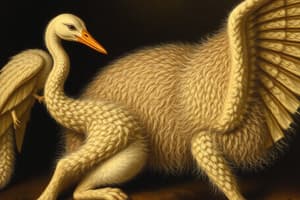Podcast
Questions and Answers
What role do behaviors play in animal survival?
What role do behaviors play in animal survival?
- They are primarily learned through social interactions.
- They help in finding food and avoiding predators. (correct)
- They have no impact on survival.
- They are only related to mating rituals.
Which systems in animal physiology are responsible for maintaining life?
Which systems in animal physiology are responsible for maintaining life?
- Muscular and integumentary systems.
- Respiratory and skeletal systems.
- Respiratory, digestive, circulatory, and nervous systems. (correct)
- Digestive and reproductive systems.
What are physiological adaptations in animals mainly for?
What are physiological adaptations in animals mainly for?
- Improving social behaviors.
- Expanding geographic range.
- Competing with other species.
- Surviving in specific environments and lifestyles. (correct)
What types of cues do animals often use for communication?
What types of cues do animals often use for communication?
How do learned behaviors differ from instinctive behaviors in animals?
How do learned behaviors differ from instinctive behaviors in animals?
What distinguishes animal cells from plant and fungal cells?
What distinguishes animal cells from plant and fungal cells?
Which characteristic is primarily associated with animals?
Which characteristic is primarily associated with animals?
Which of the following is a common phylum within the Animalia kingdom?
Which of the following is a common phylum within the Animalia kingdom?
What type of body symmetry do sponges exhibit?
What type of body symmetry do sponges exhibit?
What does the presence of a coelom indicate about an animal?
What does the presence of a coelom indicate about an animal?
Which animal behavior is generally more complex?
Which animal behavior is generally more complex?
How are animals classified into phyla?
How are animals classified into phyla?
What does the term 'heterotrophic' mean in relation to animals?
What does the term 'heterotrophic' mean in relation to animals?
Flashcards
Animal Behaviors
Animal Behaviors
Actions that help an animal survive, like finding food, escaping danger, or finding a mate.
Animal Communication
Animal Communication
Complex ways animals use to communicate through sounds, sights, or smells.
Animal Physiology
Animal Physiology
The study of how animal bodies work, from breathing to digestion and blood flow.
Physiological Adaptations
Physiological Adaptations
Signup and view all the flashcards
Animal Body Systems
Animal Body Systems
Signup and view all the flashcards
What are animals?
What are animals?
Signup and view all the flashcards
What is multicellularity?
What is multicellularity?
Signup and view all the flashcards
What is heterotrophic nutrition?
What is heterotrophic nutrition?
Signup and view all the flashcards
Why does movement matter for animals?
Why does movement matter for animals?
Signup and view all the flashcards
What is the role of the nervous system in animals?
What is the role of the nervous system in animals?
Signup and view all the flashcards
How do most animals reproduce?
How do most animals reproduce?
Signup and view all the flashcards
How are animals classified?
How are animals classified?
Signup and view all the flashcards
What is a body cavity?
What is a body cavity?
Signup and view all the flashcards
Study Notes
Defining Animalia
- Animals are multicellular eukaryotic organisms.
- They are heterotrophic, obtaining energy by consuming other organisms.
- Animal cells lack cell walls and chloroplasts, distinguishing them from plants and fungi.
- Animals exhibit a wide range of forms, sizes, and behaviors.
Key Characteristics of Animals
- Multicellularity: Composed of numerous cells organized into tissues, organs, and organ systems.
- Heterotrophic nutrition: Consume other organisms for energy and nutrients.
- Movement: Most animals are capable of movement at some stage of their life cycle.
- Nervous system: Allows for coordinated responses to stimuli.
- Reproduction: Primarily sexual, but some reproduce asexually.
Animal Classification
- Animalia is a vast kingdom, classified into various phyla based on shared characteristics.
- Phyla differ in body plans, symmetry, and developmental processes.
- Common phyla include Chordata (vertebrates and some invertebrates), Arthropoda, Mollusca, Annelida, and Cnidaria.
- Classification is based on anatomical features, evolutionary relationships, and genetic data.
Animal Body Plans
- Body symmetry: Animals can be radially symmetrical (e.g., jellyfish), bilaterally symmetrical (e.g., humans), or asymmetrical (e.g., sponges).
- Body cavities: The presence and type of body cavity (coelom) is a significant distinguishing characteristic.
- Segmentation: Some animals exhibit a segmented body plan, like the repeated units in earthworms.
- Presence of appendages: Appendages like arms, legs, or wings aid in movement and other functions.
Animal Diversity
- A vast array of species exists within the Animal kingdom.
- Animals occupy diverse habitats, from aquatic to terrestrial environments.
- Animals exhibit incredible adaptability and diverse feeding strategies to exploit resources.
- Examples include herbivores, carnivores, omnivores, and detritivores.
Animal Evolution
- Animals evolved from a single-celled ancestor.
- Evolutionary history is complex, leading to the diverse array of animals today.
- Evolutionary relationships are often reflected in anatomical similarities and genetic comparisons.
- Phylogenetic trees illustrate evolutionary relationships between different animal groups.
Animal Behavior
- Animals exhibit a wide range of behaviors, from simple reflexes to complex social structures.
- Behaviors are often related to survival, including finding food, avoiding predators, and mating.
- Some animals have intricate communication systems, using sounds, visual signals, or chemical cues.
- Behaviors range from instinctive behaviors (innate) to learned behaviors (influenced by experience).
Animal Physiology
- Animal physiology studies bodily functions, from respiration to digestion and circulation.
- Nutrient absorption, transportation, and waste removal mechanisms vary among animals.
- Physiological adaptations allow animals to thrive in specific environments and lifestyles.
- Systems like the respiratory, digestive, circulatory, and nervous systems perform vital processes for life.
Studying That Suits You
Use AI to generate personalized quizzes and flashcards to suit your learning preferences.





